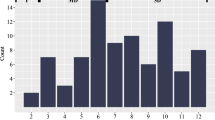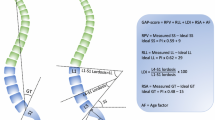Abstract
Purpose
Different methods of sagittal alignment assessment compete for predicting adverse events after adult spinal deformity (ASD) surgery. We wanted to study which method provides greater benefit.
Methods
Retrospective study of 391 patients operated for ASD, with > 6 instrumented levels, fused to the pelvis, and 2 years of follow-up. Three alignment methods were analyzed 6-week postoperatively: (1) Roussouly mismatch; (2) GAP score/GAP categories; (3) T4-L1-Hip axis. Binary logistic regression generated models that best predict the following adverse events: mechanical complications (MC): in general and isolated (PJK, PJF, rod breakage); reinterventions (in general and after MC); and readmissions. ROC/AUC analysis was also implemented. In a second regression round, we added different variables that were selected on univariate analysis—demographic, surgical, and radiographic—to complete the models.
Results
The best predictor parameters in most models were T4-L1PA mismatch and GAP score; we could not prove a predictive ability of the Roussouly mismatch. The T4-L1PA mismatch best predicted general MC, PJK, PJK + PJF, and readmission, while the GAP score best predicted PJF and reinterventions (for MC and for any complication). However, the variance explained by these models was limited (Nagelkerke's R2 = 0.031–0.113), with odds ratios ranging from 1.070 to 1.456. ROC curves plotted an AUC between 0.57 and 0.70. Introducing additional variables (demographic, surgical, and radiographic) improved prediction in all the models (Nagelkerke's R2 = 0.082–0.329) and allowed predicting rod breakage.
Conclusion
The T4-L1-Hip axis and GAP score show potential in predicting adverse events, surpassing the Roussouly method. Despite partial efficacy in complication anticipation, recognizing postoperative sagittal alignment as a key modifiable risk factor, the crucial need arises to integrate diverse variables, both modifiable and non-modifiable, for enhanced predictive accuracy.
Level of evidence
Level IV.

Similar content being viewed by others
Data availability
All data were from a multicenter European database.
References
Stagnara P, De Mauroy JC, Dran G et al (1982) Reciprocal angulation of vertebral bodies in a sagittal plane: approach to references for the evaluation of kyphosis and lordosis. Spine 7:335–342. https://doi.org/10.1097/00007632-198207000-00003
Duval-Beaupère G, Schmidt C, Cosson P (1992) A Barycentremetric study of the sagittal shape of spine and pelvis: the conditions required for an economic standing position. Ann Biomed Eng 20:451–462. https://doi.org/10.1007/BF02368136
Glassman SD, Berven S, Bridwell K et al (2005) Correlation of radiographic parameters and clinical symptoms in adult scoliosis. Spine 30:682–688. https://doi.org/10.1097/01.brs.0000155425.04536.f7
Glassman SD, Bridwell K, Dimar JR et al (2005) The impact of positive sagittal balance in adult spinal deformity. Spine 30:2024–2029
Schwab F, Farcy J-P, Bridwell K et al (2006) A clinical impact classification of scoliosis in the adult. Spine 31:2109–2114. https://doi.org/10.1097/01.brs.0000231725.38943.ab
Takemoto M, Boissière L, Vital J-M et al (2017) Are sagittal spinopelvic radiographic parameters significantly associated with quality of life of adult spinal deformity patients? Multivariate linear regression analyses for pre-operative and short-term post-operative health-related quality of life. Eur Spine J 26:2176–2186. https://doi.org/10.1007/s00586-016-4872-y
Roussouly P, Gollogly S, Berthonnaud E, Dimnet J (2005) Classification of the normal variation in the sagittal alignment of the human lumbar spine and pelvis in the standing position. Spine 30:346–353
Schwab F, Ungar B, Blondel B et al (2012) Scoliosis Research Society-Schwab adult spinal deformity classification: a validation study. Spine 37:1077–1082. https://doi.org/10.1097/BRS.0b013e31823e15e2
Yilgor C, Sogunmez N, Boissière L et al (2017) Global alignment and proportion (GAP) score. J Bone Joint Surg 99:1661–1672. https://doi.org/10.2106/JBJS.16.01594
Hills J, Lenke LG, Sardar ZM et al (2022) The T4–L1-Hip axis: defining a normal sagittal spinal alignment. Spine 47:1399–1406. https://doi.org/10.1097/BRS.0000000000004414
Passias PG, Pierce KE, Raman T et al (2021) Does matching roussouly spinal shape and improvement in SRS-Schwab modifier contribute to improved patient-reported outcomes? Spine 46:1258–1263. https://doi.org/10.1097/BRS.0000000000003999
Liu Y, Liu Z, Zhu F et al (2013) Validation and reliability analysis of the new SRS-Schwab classification for adult spinal deformity. Spine 38:902–908. https://doi.org/10.1097/BRS.0b013e318280c478
Terran J, Schwab F, Shaffrey CI et al (2013) The SRS-Schwab adult spinal deformity classification: assessment and clinical correlations based on a prospective operative and nonoperative cohort. Neurosurgery 73:559–568. https://doi.org/10.1227/NEU.0000000000000012
Sebaaly A, Gehrchen M, Silvestre C et al (2019) Mechanical complications in adult spinal deformity and the effect of restoring the spinal shapes according to the Roussouly classification: a multicentric study. Eur Spine J 37:1763–1810. https://doi.org/10.1007/s00586-019-06253-1
Bari TJ, Ohrt-Nissen S, Hansen LV et al (2019) Ability of the global alignment and proportion score to predict mechanical failure following adult spinal deformity surgery-validation in 149 patients with two-year follow-up. Spine Deformity 7:331–337. https://doi.org/10.1016/j.jspd.2018.08.002
Kwan KYH, Lenke LG, Shaffrey CI et al (2021) Are higher global alignment and proportion scores associated with increased risks of mechanical complications after adult spinal deformity surgery? An external validation. Clin Orthop Relat Res 479:312–320. https://doi.org/10.1097/CORR.0000000000001521
Gupta MC, Yilgor C, Moon HJ et al (2021) Evaluation of global alignment and proportion score in an independent database. Spine J 21:1549–1558. https://doi.org/10.1016/j.spinee.2021.04.004
Jacobs E, van Royen BJ, van Kuijk SMJ et al (2019) Prediction of mechanical complications in adult spinal deformity surgery-the GAP score versus the Schwab classification. Spine J 19:781–788. https://doi.org/10.1016/j.spinee.2018.11.013
Sun X, Sun W, Sun S et al (2021) Which sagittal evaluation system can effectively predict mechanical complications in the treatment of elderly patients with adult degenerative scoliosis? Roussouly classification or Global Alignment and Proportion (GAP) Score. J Orthop Surg Res 16:641–649. https://doi.org/10.1186/s13018-021-02786-8
Passias PG, Bortz C, Pierce KE et al (2022) Comparing and contrasting the clinical utility of sagittal spine alignment classification frameworks: Roussouly versus SRS-Schwab. Spine 47:455–462. https://doi.org/10.1097/BRS.0000000000004300
Teles AR, Aldebeyan S, Aoude A et al (2022) Mechanical complications in adult spinal deformity surgery: can spinal alignment explain everything? Spine 47:E1–E9. https://doi.org/10.1097/BRS.0000000000004217
Laouissat F, Sebaaly A, Gehrchen M, Roussouly P (2017) Classification of normal sagittal spine alignment: refounding the Roussouly classification. Eur Spine J 18:40–10. https://doi.org/10.1007/s00586-017-5111-x
Quarto E, Zanirato A, Pellegrini M et al (2022) GAP score potential in predicting post-operative spinal mechanical complications: a systematic review of the literature. Eur Spine J 31:3286–3295. https://doi.org/10.1007/s00586-022-07386-6
Pizones J, Perez-Grueso FJS, Moreno-Manzanaro L et al (2020) Ideal sagittal profile restoration and ideal lumbar apex positioning play an important role in postoperative mechanical complications after a lumbar PSO. Spine Deformity 8:491–498. https://doi.org/10.1007/s43390-019-00005-3
Soroceanu A, Diebo BG, Burton D et al (2015) Radiographical and implant-related complications in adult spinal deformity surgery: incidence, patient risk factors, and impact on health-related quality of life. Spine 40:1414–1421. https://doi.org/10.1097/BRS.0000000000001020
Yilgor C, Sogunmez N, Yavuz Y et al (2017) Relative lumbar lordosis and lordosis distribution index: individualized pelvic incidence-based proportional parameters that quantify lumbar lordosis more precisely than the concept of pelvic incidence minus lumbar lordosis. Neurosurg Focus 43:E5-9. https://doi.org/10.3171/2017.8.FOCUS17498
Noh SH, Ha Y, Park JY et al (2021) Modified global alignment and proportion scoring with body mass index and bone mineral density analysis in global alignment and proportion score of each 3 categories for predicting mechanical complications after adult spinal deformity surgery. Neurospine 18:484–491. https://doi.org/10.14245/ns.2142470.235
Ohba T, Ebata S, Oba H et al (2019) Predictors of poor global alignment and proportion score after surgery for adult spinal deformity. Spine 44:E1136–E1143. https://doi.org/10.1097/BRS.0000000000003086
Pizones J, Moreno-Manzanaro L, Sánchez Pérez-Grueso FJ et al (2019) Restoring the ideal Roussouly sagittal profile in adult scoliosis surgery decreases the risk of mechanical complications. Eur Spine J 14:925. https://doi.org/10.1007/s00586-019-06176-x
Steyerberg EW, Vickers AJ, Cook NR et al (2010) Assessing the performance of prediction models: a framework for traditional and novel measures. Epidemiology 21:128–138. https://doi.org/10.1097/EDE.0b013e3181c30fb2
Ignasiak D, Behm P, Mannion AF et al (2023) Association between sagittal alignment and loads at the adjacent segment in the fused spine: a combined clinical and musculoskeletal modeling study of 205 patients with adult spinal deformity. Eur Spine J 32:571–583. https://doi.org/10.1007/s00586-022-07477-4
Katsu M, Ohba T, Ebata S et al (2020) Potential role of paraspinal musculature in the maintenance of spinopelvic alignment in patients with adult spinal deformities. Clin Spine Surg 33:E76–E80. https://doi.org/10.1097/BSD.0000000000000862
Miller EK, Neuman BJ, Jain A et al (2017) An assessment of frailty as a tool for risk stratification in adult spinal deformity surgery. Neurosurg Focus 43:E3. https://doi.org/10.3171/2017.10.FOCUS17472
Safaee MM, Ames CP (2023) Biological age and spine surgery-genomics and the future of risk assessment. World Neurosurg 172:47. https://doi.org/10.1016/j.wneu.2023.02.011
Acknowledgements
This study was presented at the GEER meeting 2023.
Funding
A DePuy Synthes Spine and Medtronic research grants were received in partial support of this work. The device(s)/drug(s) is/are FDA approved or approved by the corresponding national agency for this indication. No benefits in any form have been or will be received from a commercial party related directly or indirectly to the subject of this manuscript.
Author information
Authors and Affiliations
Consortia
Contributions
All authors have done the following: Substantial contributions to the conception and design of the work, acquisition, analysis, or interpretation of data. Drafting the work and revising it critically for important intellectual content. Final approval of the version to be published. And all authors agree to be accountable for the author’s own contributions and for ensuring that questions related to the accuracy or integrity of any part of the work, even ones in which the author was not personally involved, are appropriately investigated, resolved, and documented in the literature.
Corresponding author
Ethics declarations
Conflict of interest
Javier Pizones, Jeffrey Hills, Lucía Moreno-Manzanaro, and Francisco Javier Sánchez Perez-Grueso have nothing to disclose. Michael Kelly received honorarium from Wolters Kluwer. Caglar Yilgor is a Consultant for Medtronic. Frank Kleinstück did teaching and speaking for DePuy Synthes. Ibrahim Obeid received grants from DePuy synthes and did consulting for DePuy synthes, Medtronic, Clariance, Spineart, Alphatec. Ahmet Alanay received grants from Medtronic, DePuy Synthes is a Consultant for Globus medical and ZimVie. Ferran Pellisé is a Consultant for Medtronic and Depuy Synthes.
Institutional review board
Ethical approval was obtained before patient enrollment and data collection protocols. The procedures used in this study adhere to the tenets of the Declaration of Helsinki.
Informed consent
All the participating patients gave prior informed consent to their inclusion in this study. Patients signed informed consent regarding publishing their data and photographs.
Additional information
Publisher's Note
Springer Nature remains neutral with regard to jurisdictional claims in published maps and institutional affiliations.
Rights and permissions
Springer Nature or its licensor (e.g. a society or other partner) holds exclusive rights to this article under a publishing agreement with the author(s) or other rightsholder(s); author self-archiving of the accepted manuscript version of this article is solely governed by the terms of such publishing agreement and applicable law.
About this article
Cite this article
Pizones, J., Hills, J., Kelly, M. et al. Which sagittal plane assessment method is most predictive of complications after adult spinal deformity surgery?. Spine Deform (2024). https://doi.org/10.1007/s43390-024-00864-5
Received:
Accepted:
Published:
DOI: https://doi.org/10.1007/s43390-024-00864-5




